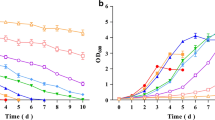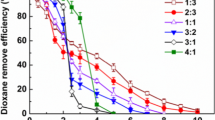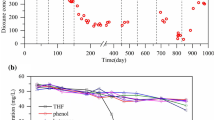Abstract
A mixed microbial culture capable of growing aerobically on tetrahydrofuran (THF) as a sole carbon and energy source was used as the inoculum in a 10 l working volume membrane bioreactor. Following start-up, the reactor was operated in batch mode for 24 h and then switched to continuous feed with 100% biomass recycle. On average, greater than 96% of THF fed to the reactor was removed during the 8-month study. THF loading rates ranged from 0.62 to 9.07 g l−1 day−1 with a hydraulic retention time of 24 h. THF concentrations as high as 800 mg/l were tolerated by the culture. Biomass production averaged 0.28 kg total suspended solids/kg chemical oxygen demand removed, i.e., comparable to a conventional wastewater treatment process. Periodic batch wasting resulted in a solids retention time of 7–14 days. Reactor biomass typically ranged from 4 to 10 g/l volatile suspended solids and the effluent contained no solids. Pure THF-degrading cultures were isolated from the mixed culture based on morphological characteristics, Gram-staining and THF degradation. Based on 16S rDNA analysis the isolates were identified as Pseudonocardia sp. M1 and Rhodococcus ruber M2.







Similar content being viewed by others
References
American Public Health Association (1995) Standard methods for the examination of water and wastewater, 19th edn. American Public Health Association, Washington, D.C.
Atlas R (1995) Handbook of media for environmental microbiology. CRC Press, Boca Raton, Fla.
Bailey AD, Hansford GS, Dold PL (1994) The use of crossflow microfiltration to enhance the performance of an activated sludge reactor. Water Res 28:297–301
Bernhardt B, Diekmann H (1991) Degradation of dioxane, tetrahydrofuran and other cyclic ethers by an environmental Rhodococcus strain. Appl Microbiol Biotechnol 36:120–123
Bock C, Kroppenstedt RM, Diekmann H (1996) Degradation and bioconversion of aliphatic and aromatic hydrocarbons by Rhodococcus ruber 219. Appl Microbiol Biotechnol 45:408–410
Chiemchaisri S, Yamamota K, Vigneswaran S (1993) Household membrane bioreactor in domestic wastewater treatment. Water Sci Technol 27:171–178
Churchouse SJ (1997) Operating experiences with the Kubota submerged activated sludge process. 1st International Meeting on Membrane Bioreactors for Wastewater Treatment, 5–6 March 1997, Cranfield University, UK. Cranfield University: School of Water Sciences and Water Biotreatment Club, p 11
Cicek N, Winnen H, Suidan MT, Wrenn BE, Urbain V, Manem J (1998) Effectiveness of the membrane bioreactor in the biodegradation of high molecular weight compounds. Water Res 32:1553–1563
Cicek N, Franco JP, Suidan MT, Urbain V, Manem J (1999) Characterization and comparison of a membrane bioreactor and a conventional activated-sludge system in the treatment of wastewater containing high-molecular-weight compounds. Water Environ Res 71:64–70
Draper AJ, Manda A, Parkinson A (1997) Inhibition of coumarin 7-hydroxylase activity in human liver microsomes. Arch Biochem Biophys 341:47–61
Ergas SJ, Shumway L, Fitch MW, Neemann JJ (1998) Membrane process for biological treatment of contaminated gas streams. Biotechnol Bioeng 63:431–441
Fan X, Urbain V, Qian Y, Manem J (1996) Nitrification and mass balance with a MBR for municipal wastewater treatment. 18th IAWQ Biennial International Conference and Exhibition, 23–28 June 1996, Singapore
Felsenstein DL (1985) Confidence limits on phylogenies: an approach using bootstrap. Evolution 39:783–791
Gander MA, Jefferson B, Judd SJ (2000) Membrane bioreactors for use in small wastewater treatment plants: membrane materials and effluent quality. Water Sci Technol 41:205–211
Higgins DG, Bleasby AJ, Fuchs R (1996) Clustal V: improved software for multiple sequence alignment. Comput Appl Biosci 8:189–191
Huyard A, Trouve E, Manem J (1992) Recent advances on bioreactor applications to water and wastewater treatment. Proceedings of the Euromembrane Interfiltra Conference, 21–22 June 1992, Paris
Jukes TH, Cantor CR (1969) Evolution of protein molecules. In: Munro HN (ed) Mammalian protein metabolism. Academic Press, New York, pp 21–132
Kohlweyer U, Thiemer B, Schrader T, Andresen JR (2000) Tetrahydrofuran degradation by a newly isolated culture of Pseudonocardia sp. strain K1. FEMS Microbiol Lett 186:301–306
Konopka A, Zakharova T, Oliver L, Camp D, Turco RF (1996) Biodegradation of organic wastes containing surfactants in a biomass recycle reactor. Appl Environ Microbiol 62:3292–3297
Leonard D, Mercier-Bonin M, Lindley ND, Lafforgue C (1998) Novel membrane bioreactor with gas/liquid two-phase flow for high-performance degradation of phenol. Biotechnol Prog 14:680–688
Lu SG, Imai T, Ukita M, Sekine M, Fukagawa M, Nakanishi H (1999) Fermentation wastewater treatment in a membrane bioreactor. Environ Technol 20:431–436
Maddison WP, Maddison DR (1992) Interactive analysis of phylogeny and character evolution using the computer program MacClade. Folia Primatol 53:190–202
Moody DE (1991) The effect of tetrahydrofuran on biological systems: does a hepatotoxic potential exist? Drug Chem Toxicol 14:319–342
Muller EB, Stouthamer AH, van Verseveld AH, Eikelboom HW (1995) Aerobic domestic waste water treatment in a pilot plant with complete sludge retention by cross-flow filtration. Water Res 29:1179–1189
Painter HA, King EF (1985) Ring test programme 1983–84; assessment of biodegradability of chemicals in water by manometric respirometry. EUR 9962 CA 103:182390. Contract nr XI/W/83/238. Commission of the European Communities, Water Research Centre, Elder Way, UK
Parales RE, Adamus JE, White N, May HD (1994) Degradation of 1,4-dioxane by an Actinomycete in pure culture. Appl Environ Microbiol 60:4527–4530
Pressman JG, Georgiou G, Speitel GE Jr (1998) Demonstration of efficient trichloroethylene biodegradation in a hollow-fiber membrane bioreactor. Biotechnol Bioeng 62:681–692
Reij MW, Keurentjes JTF, Hartmans S (1998) Membrane bioreactors for waste gas treatment. J Biotechnol 59:155–167
Scott JA, Neilson DJ, Liu W, Boon PN (1998) A dual function membrane bioreactor system for enhanced aerobic remediation of high-strength industrial waste. Water Sci Technol 38:413–420
Swafford DL (1999) PAUP*: phylogenetic analysis using parsimony (and other methods). Sinauer, Sunderland, Mass.
Thompson JD, Higgins DG, Gibson TJ (1994) CLUSTAL W: Improving the sensitivity of progressive multiple sequence alignment through sequence weighting, positions-specific gap penalties and weight matrix choice. Nucleic Acids Res 22:4673–4680
Van Dijk L, Roncken GCG (1997) Membrane bioreactors for wastewater treatment: the state of the art and new developments. Water Sci Technol 35:35–41
Weber FJ, de Bont JAM (1996) Adaptation mechanisms of microorganisms to the toxic effect of organic solvents on membranes. Biochem Biophys Acta 1286:225–245
Winnen H, Suidan MT, Scarpino PV, Wrenn B, Cicek N, Urbain V, Manem J (1996) Effectiveness of the membrane bioreactor in the biodegradation of high molecular-weight compounds. Water Sci Technol 34:197–203
Acknowledgements
Merck & Co., Inc. funded this work through funds from the New Technology Committee (Estimate 975052).
Author information
Authors and Affiliations
Corresponding author
Rights and permissions
About this article
Cite this article
Daye, K.J., Groff, J.C., Kirpekar, A.C. et al. High efficiency degradation of tetrahydrofuran (THF) using a membrane bioreactor: identification of THF-degrading cultures of Pseudonocardia sp. strain M1 and Rhodococcus ruber isolate M2. J IND MICROBIOL BIOTECHNOL 30, 705–714 (2003). https://doi.org/10.1007/s10295-003-0103-8
Received:
Accepted:
Published:
Issue Date:
DOI: https://doi.org/10.1007/s10295-003-0103-8




